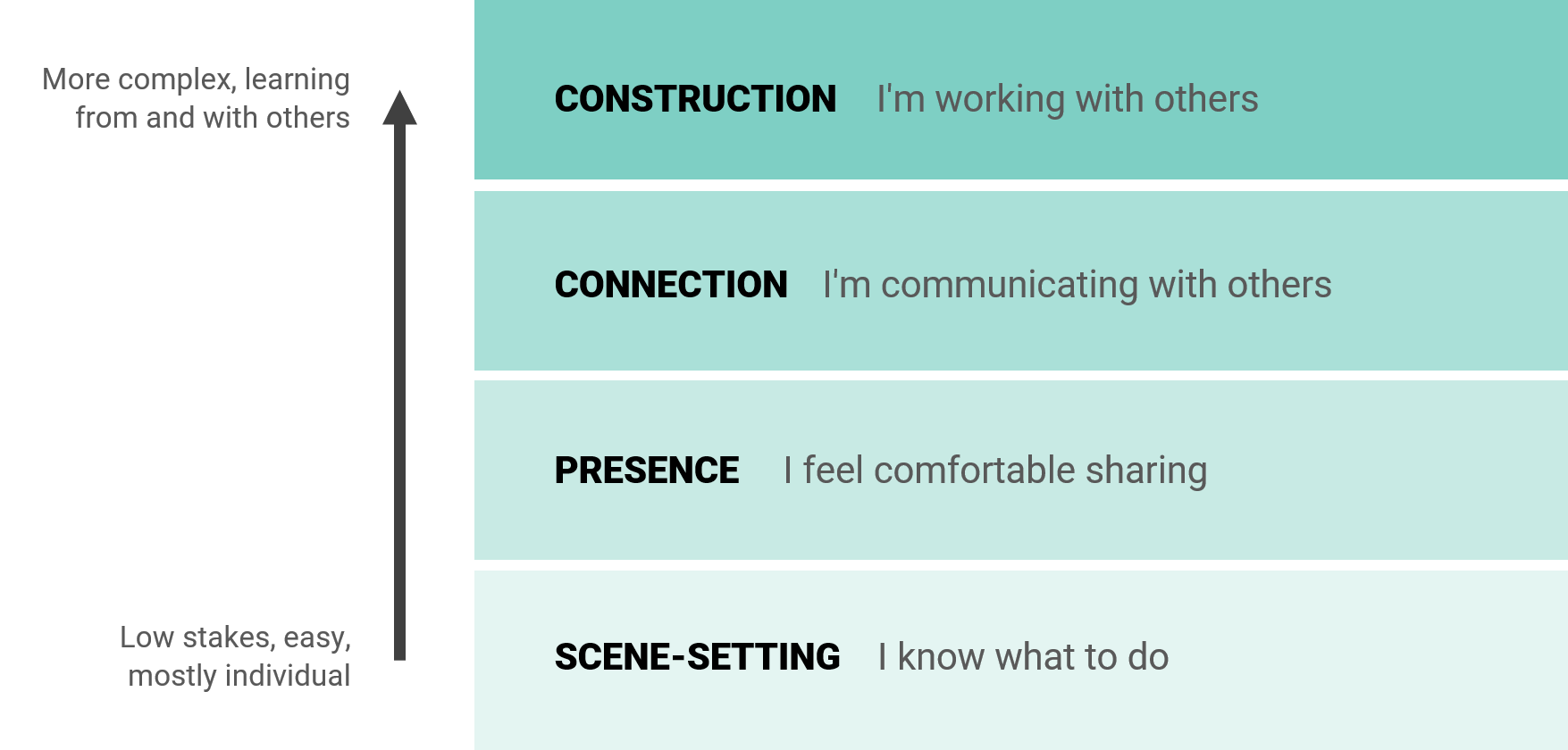In learning, having an online community for a course can motivate learners and improve outcomes. Learning happens in discussions between people and in the social relationships that bind them. When learners have an online community they have broader possibilities to reach new sources of information. They can share new ideas, opinions and experiences and collaborate with others.
In fact, many platforms these days work by encouraging the creation and exchange of user-generated content (think Instagram, Linkedin, Reddit). And in these platforms, users often also chat with one another and make connections.
In online learning, "discussion spaces" are the framework for interactions. In iQualify these can take the form of talk channels, in-page discussions (built by the author) or social notes. But… just setting up a discussion space (talk channel) won’t automatically lead to a community. So how do we build a communitiy?
In the remainder of this post, we’ll look at:
- what makes an online community a “community”
- how communities improve learning
- suggestions for how you can build them.
What is an online community?
Online communities are essentially social networks centered around learning (generally a specific topic). Online communities have many names – professional learning communities, communities of learners (and all other permutations you could cook up). One of the more common phrases is “community of practice” which is defined as:
“groups of people who share a concern, a set of problems, or a passion about a topic, and who deepen their knowledge and expertise in this area by interacting on an ongoing basis” - Etienne and Beverly Wenger-Trayner.
So… people who learn about a particular “thing” by interacting with one another.
For many courses, learners’ interactions are over a set time (often 2-4 months) rather than ongoing. But, that said, we still think there's a lot of value in building a community “feel” in an online course. If you get a bit of a community up and running, you'll find that these connections can and do persist past the length of the course.
How do online communities support learning?
More support - Learners have a large group to call on when they are feeling stuck. This is especially important for learners on the periphery who don't feel as comfortable approaching the facilitator. These online communities can overcome barriers of time and geography. Learners can have their questions answered quickly by any number of people, so they can get on with study.
-
More information - share information and resources with the facilitator and fellow learners. Reciprocal exchange relationships crucial to the network leading to learning.
-
More motivation - Learners feel a stronger sense of connection and belonging (isolation is often a contributing factor in learners dropping out).
-
More experience - Learners can learn from others' experiences and knowledge. The wisdom of the crowd. Stories can be told, reflected back, heard in different ways, retold, and relived in new ways.
-
More reflection - In hearing the stories of others, learners contemplate their own experiences and reflect on how they compare.
-
More reasoning - In discussion, learners' explanations and reasoning become visible. They don't just live in the individual learner's head.
-
More negotiation – Discussion involves constant negotiation. Learners need to weigh up different options or explanations to reach joint conclusions.
-
More visibility - There is a record of nearly everything that occurs in that environment. All conversations are accessible to learners at any time and from anywhere. They aren't stored in emails between just one learner and the facilitator.
-
More freedom and ownership – Learners aren't necessarily restricted to talking about what the facilitator wants to talk about, they can discuss what they want and dive into particular areas of interest. This also personalises the space for the learner and leads to greater ownership.
What does an online community need?
In thinking about what makes these communities work and what they need, we found parallels and similarities across areas like business and organisational management, teaching and learning, and cultural competence. Finding these sorts of similarities is comforting. It makes us think: Okay, there’s got to be some “truth” to be found here... things that work across context and learners.
Common themes in what these communities need are:
- a reason for exisiting
- "rules" around membership
- a clear benefit for participants – "what's in it for me?"
- enough members contributing (reasonably frequently) to sustain conversation from participants
- engagement from the facilitator (especially in the beginning)
How can I build an online community?
Often online learners do not know each before the course. And because they can't see one another and the social cues that come with this, the socialisation process can take far longer. Simply setting up a place for discussion and a contentious question or group task is not enough. We (me, you, your learners) may be increasingly comfortable using other social sites or apps. But we are still grappling with strategies to ensure these social spaces lead to better learning and aren’t just “noise”.
Online communities are great if they happen organically, but often they need a bit of a helping hand. It's best to build socialisation and trust starting with low stakes activities that allow learners to explore and share. So we've come up with a progression of tiers that increase in complexity and level of interaction with others.
Then we've come up with activities that fit in those tiers and flow on from one another.

You might choose to include just the activities from one "column" or you might choose to do all of the first tier, then only the second column for the rest of the tiers.
A note on group size and formation
There’s no hard and fast rule for the size of a group for discussion. However, too few and the discussion can peter out, too many and there’s too much noise. As the number of messages increases, it can get difficult to manage for both learners and facilitators. You don’t want learners to have to sort through irrelevant posts. Most advice on group size that promotes cooperative behaviour is somewhere between 10-20 participants. If you’ve got a larger group, consider subdividing the group and restricting the interactions of players to local neighbourhoods. And don’t get overly caught up in how to divvy up learners, random selection has proven to be as effective as more sophisticated approaches or selecting who is in which group.
Find out more
Check out our further articles on each stage to give you a few different ideas.These include example text you could reuse for your own context.
Scene-setting >> Presence >> Connection >> Construction
If you’re interested in iQualify and how it could transform your business check out www.iqualify.com



